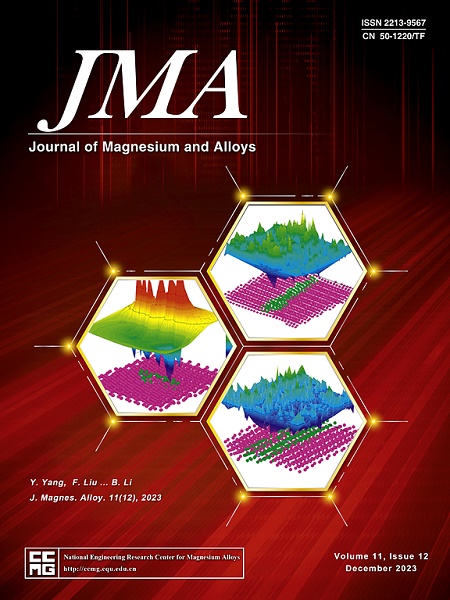Microstructure evolution and mechanical properties of large-size AZ31 magnesium alloy block fabricated by wire arc additive manufacturing
IF 15.8
1区 材料科学
Q1 METALLURGY & METALLURGICAL ENGINEERING
引用次数: 0
Abstract
With the urgent demand for lightweight and integrated structural parts in the aerospace field, the use of cold metal transfer wire arc additive manufacturing (CMT-WAAM) to form large-size magnesium alloy structural parts has become a research hotspot. In this paper, a large AZ31 magnesium alloy multilayer block with a lower porosity was successfully prepared by CMT-WAAM. The AZ31 block exhibits a fully equiaxed grain morphology, the average grain diameters of the top, middle, and bottom are 16.1 µm, 12.4 µm, and 10.4 µm, respectively. The submicron spherical particles measuring 0.09 to 0.4 µm are Mg17Al12 phases, irregular particles are Al8Mn5 + Mg17Al12 composite phases and large particles measuring 5 to 10 µm are Al8Mn5 in AZ31 block. The UTS of CMT-WAAM AZ31 block from the bottom of 239.9 ± 5.0 MPa to the top of 237.3 ± 3.1 MPa, and the EL from the bottom of 22.7 ± 0.6% to the top of 30.0 ± 1.1%, exceeding the casting standards. In the CMT-WAAM processed AZ31 alloy, the pre-existing coarse second phase particles in the AZ31 filaments acted as nucleating agents, and the electromagnetic stirring effect in the WAAM process broke up the dendrites and increased the number density of nucleation sites to improve the rate of nucleation, and the complex thermal conditions in the WAAM process restricted the growth of the grains and the precipitated phases. The mechanical properties of AZ31 alloy were improved by effectively refining its grain size and precipitated phase size.
电弧增材制造大尺寸AZ31镁合金块体的组织演变及力学性能
随着航空航天领域对结构件轻量化、集成化的迫切需求,利用冷金属转移丝电弧增材制造(CMT-WAAM)成形大尺寸镁合金结构件已成为研究热点。本文采用CMT-WAAM法制备了低孔隙率的AZ31镁合金多层块体。AZ31块体呈完全等轴晶粒形貌,顶部、中部和底部的平均晶粒直径分别为16.1µm、12.4µm和10.4µm。AZ31块体中尺寸为0.09 ~ 0.4µm的亚微米球形颗粒为Mg17Al12相,不规则颗粒为Al8Mn5 + Mg17Al12复合相,尺寸为5 ~ 10µm的大颗粒为Al8Mn5。CMT-WAAM AZ31块体的UTS从底部为239.9±5.0 MPa到顶部为237.3±3.1 MPa, EL从底部为22.7±0.6%到顶部为30.0±1.1%,均超过铸造标准。在CMT-WAAM加工的AZ31合金中,AZ31细丝中预先存在的粗第二相颗粒作为成核剂,WAAM过程中的电磁搅拌作用破坏了枝晶,增加了成核位点的数量密度,提高了成核速率,WAAM过程中复杂的热条件限制了晶粒和析出相的生长。通过有效细化AZ31合金的晶粒尺寸和析出相尺寸,提高了AZ31合金的力学性能。
本文章由计算机程序翻译,如有差异,请以英文原文为准。
求助全文
约1分钟内获得全文
求助全文
来源期刊

Journal of Magnesium and Alloys
Engineering-Mechanics of Materials
CiteScore
20.20
自引率
14.80%
发文量
52
审稿时长
59 days
期刊介绍:
The Journal of Magnesium and Alloys serves as a global platform for both theoretical and experimental studies in magnesium science and engineering. It welcomes submissions investigating various scientific and engineering factors impacting the metallurgy, processing, microstructure, properties, and applications of magnesium and alloys. The journal covers all aspects of magnesium and alloy research, including raw materials, alloy casting, extrusion and deformation, corrosion and surface treatment, joining and machining, simulation and modeling, microstructure evolution and mechanical properties, new alloy development, magnesium-based composites, bio-materials and energy materials, applications, and recycling.
 求助内容:
求助内容: 应助结果提醒方式:
应助结果提醒方式:


